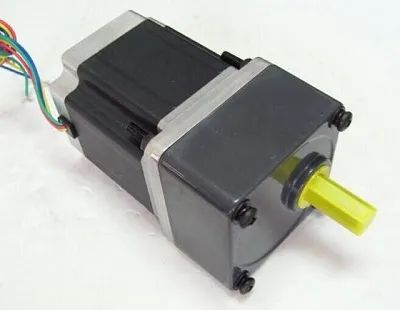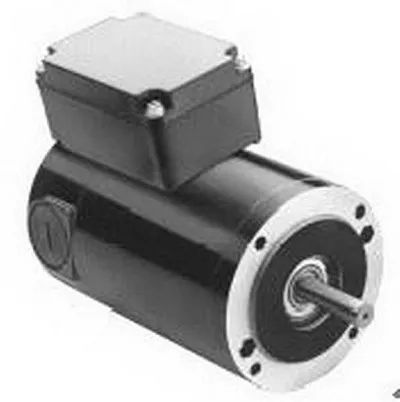Main classification of brushless DC motor rotor position sensors
1. Electromagnetic position sensor
Electromagnetic position sensors use electromagnetic effects to achieve position measurement. They mainly include open transformer type, resonant proximity switches, etc.
The open transformer position sensor consists of two parts: the stator and the rotor. The stator can be made of laminated silicon steel sheets, or
Made of high-frequency ferrite material. The open transformer stator in a 2-pole three-phase brushless DC motor has six
The teeth are spaced 60° apart. Three of the teeth are wound with a primary winding, and are connected in series with each other to be powered by a high-frequency oscillation power supply (generally a frequency of several kilohertz to tens of kilohertz); the other three teeth are each wound with a secondary winding, and they are respectively 120° apart. The rotor is a disc made of non-magnetic material, and is inlaid with a piece of magnetically conductive material in the shape of a sector of about 120°. Install it coaxially with the motor. The working principle of an open-ended transformer is similar to that of a general rotary transformer. The output of the three secondary windings is a high-frequency signal modulated by the rotor position. After demodulation, it is logically processed to obtain a commutation control signal.

The structure of the resonant proximity switch position sensor is similar to that of an open transformer, but it does not require high-frequency excitation on the primary side. In a three-phase motor, its stator has a resonant circuit composed of three inductance elements. The rotor is a sector-shaped conductive metal disk with an angle of about 120°. When the sector-shaped metal part of the rotor is close to the inductance component, the quality factor Q value of the circuit decreases. , causing the circuit to have insufficient positive feedback and stop oscillation, so the output is zero. When the sector-shaped metal rotor leaves the inductive element, the Q value of the circuit begins to rise, and the circuit starts to oscillate again and outputs a high-frequency modulation signal. The outputs of the three resonant circuits are high-frequency signals modulated by the rotor position. After detection and demodulation, they are logically processed to obtain the rotor position signal.
Electromagnetic position sensors have the advantages of reliable operation and adaptability to harsh operating environments. However, this kind of sensor has a low signal-to-noise ratio, poor positional resolution, and large size, so it is rarely used.
2. Photoelectric position sensor

The photoelectric position sensor works based on the principle of photoelectric effect. It consists of a light-emitting tube-photosensitive receiving tube assembly placed on the stator and a light shield that rotates with the motor rotor.
In a three-phase brushless DC motor, the light shield has a gap of about 120° (electrical angle), and the number of gaps is equal to the number of pole pairs of the rotor magnetic poles of the brushless DC motor. When the gap faces the phototransistor, the phototransistor receives the light emitted by the light source and generates a "bright current" output. When the light shield blocks the light, the phototransistor only outputs "dark current". The light shield rotates with the rotor, and the photosensitive transistor takes turns outputting "bright current" or "dark current" signals as the rotor rotates, thereby detecting the position of the rotor's magnetic poles and controlling the commutation of the three-phase windings of the motor. The disadvantage of the photoelectric position sensor is that the photoelectric signal is easily affected by dust or moisture and has low reliability.
3. Magnetic position sensor
Magnetic position sensors are made using semiconductor elements that are sensitive to magnetic fields, such as Hall effect or magnetoresistive effect elements. Common magnetic-sensitive position sensors include Hall elements or Hall integrated circuits, magnetoresistors, and magnetic diodes. Among them, Hall elements and Hall integrated circuits based on the Hall effect principle are collectively called Hall effect magnetic sensors, or Hall sensors for short. When a current passes through a semiconductor in a magnetic field, a voltage (Hall electromotive force) is generated laterally. This phenomenon was later called the Hall effect. The Hall element works based on the principle that the Hall electromotive force it generates is proportional to the orthogonal magnetic field strength. However, the Hall element is thin and brittle, and its Hall electromotive force is small. It requires a peripheral amplification circuit and is inconvenient to use.
The Hall integrated circuit is based on the principle of the Hall effect and is made using integrated packaging and assembly processes. It integrates Hall elements and necessary peripheral circuits. It can easily convert magnetic field signals into larger amplitude electrical signals. signals, and at the same time have the requirements to withstand the industrial application environment and work reliably. The Hall integrated circuit has the characteristics of no contact, low power consumption, long service life, and high response frequency. It is integrated with plastic packaging materials, so it can work reliably in various harsh environments. Because Hall position sensors have the advantages of simple structure, small size, flexible and convenient installation, easy electromechanical integration, and low price, they are currently widely used. Currently, Hall integrated circuit sensors are the most commonly used rotor position sensors in brushless DC motors.



























 XINDA
XINDA